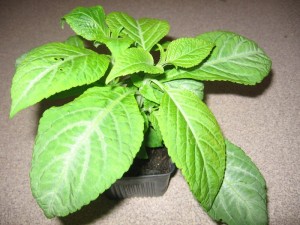How to grow and care for your Salvia divinorum plants
 Summary
Summary
Salvia divinorum can be grown quite easily in the home or greenhouse. It prefers shade, water, warmth, and humid air. Allow for air circulation but protect from strong winds because the stems are brittle and break easily. Grow in humus-rich but well-drained soil. Never allow a potted Salvia divinorum plant to sit in water. Protect from hot mid-day sun. Most garden pests like aphids, white-fly, spider mites, etc. can be controlled with weekly or monthly applications of Neem oil from the Neem Tree (Azadirachta indica). If you live in a cold winter climate, take cuttings in late fall before frost and root them indoors in water or a soil-free perlite/coco-coir based mix.
Detailed growing information
Salvia divinorum grows natively in a mountainous region near Oaxaca, Mexico, between 1000′ to 6000′. Oaxaca is a semi-tropical country; it is warm year -round and humid in the rainy season (May-Sept). Day/night temperatures average about 80degF/55degF and it rarely drops below 40degF (35.6degF is the all-time record low). Salvia divinorum grows beneath the forest canopy, in protected spots near mountain streams where it can got lots of water, and the relative humidity is always high. It grows as a large, sprawling bush with stems elongating to 7-10 feet or more. As they grow, they bend under their own weight until they come into contact with the ground where they’ll root and start a new plant. It rarely flowers or sets viable seed, its natural pollinator is unknown. Bloom season is September- May. Flowers are white and hairy on purplish calyxes.
Bearing this in mind, Salvia divinorum cannot survive in climates that dip below 32degF, and morning frost will damage the leaves. This rules it out as a landscape plant for most people living in the northern hemisphere.
Salvia plants should be grown in a pot and either put in a heated greenhouse (non-heated okay if temps don’t dip below 40degF), or grown in a pot and brought indoors for the winter. Salvia will do fine by a window sill that gets morning sun or indirect light, and does not get too hot. It can even be grown as a houseplant however its growth will be strechy and leggy, and the leaves may dry out slightly and burn around the edges due to the typically low humidity in most homes. (Humidity should be 50% or higher). That’s why it is best to grow it outdoors in a shaded spot during the summer where it will be healthy and strong, and brought inside the home in late fall to “winter over.”
Salvia divininorum needs a humus-rich soil that is well-draining. Humus is another word for matured compost or organic matter that will not break down further. High concentrations of manure, castings, or guano can burn the roots. Make your own soil with 1 part matured compost, 1 part coco-coir or shredded sphagnum peat moss, and 1 part sand, perlite, or pumice. Or you can buy any general purpose, well-draining potting mix.
Grow Salvia divinorum in a shaded location out of direct sun that also provides protection from strong winds. Stems are brittle and a strong gust can break them. However, make sure to allow space so air can circulate around the plant. This does two things: first, letting the stems gently sway in the wind makes them stronger and thicker; second, air circulation helps to thwart pests like spider mites and whitefly which thrive in stagnated, cramped conditions. Give the plant plenty of room to breathe. Too much sun will cause the leaves to yellow and burn. Ideally, the plant would grow under the filtered-light of a tree canopy that shifts throughout the day, allowing some sun to pass though.
For greenhouse growers, make sure to use a 50% shade cloth or compound over the plastic. Salvia divinorum enjoys daily misting, but permanently wet leaves will promote fungal spots. Monitor the temperature in the greenhouse during hot weather, and keep it under 87degF. Excessive heat will cause the plant to stress, transpire faster and require more water. Symptoms of too much heat are plants that are droopy; eventually, leaves burned on the edges. Use fans or an exhaust system to expell hot air and to suck in cooler air from the outside.
Salvia needs regular water, do not let the plant dry out or it will shrivle. Also, if using a saucer under the pot, make sure the plant never sits in standing water for longer than a few minutes because the roots will start to rot (due to a lack of oxygen). Eventually, the plant will droop over and die. If you smell a moldly or anaerobic foul odor, root rot may be present (In this case let it dry out somewhat before watering, or use a 20:1 water:bleach(or Physan) drench. I recommend not using saucers, unless really necessary in the home for example.
Fertilize Salvia divinorum regularly but weakly during the growing season. Weak applications (1/2 the reccomended regular dose) of fish emulsion/seaweed, compost tea, or worm castings, once a month is adequate. If growing the plant in the house use a synthetic fertilizer like Scotts, because organic fertilizers will stink up your home and attract ants! Give the plants a good flushing out with water (or rain better yet) once a month because (especially synthetic) fertilizers will cause toxic salts to buildup in the soil. Too high of salt levels will kill your plant.
A wise friend once told me, “The best fertilizer for a plant is the grower’s shadow”. Very true indeed. Pay attention to your plants needs, give them what they want, and feel the love! Doing this will guantee a healthy Salvia divinorum plant.
Also see Salvia divinorum Pest Control
Recommended Reading: